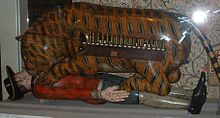

{{cite book}}: Empty citation (help)
{{cite book}}: Empty citation (help)
longer pieces
- Lives of Indian Images By Richard H. Davis, American Council of Learned Societies extended discussion of the tiger
- Indian Renaissance By Hermione De Almeida, George H. Gilpin another extended discussion
general/short descriptions
- Pearce, Susan M.; Flanders, Rosemary; Hall, Mark; Morton, Fiona (2002). Imperial Voices. The Collector's Voice. Vol. 3. Ashgate Publishing. p. 27. ISBN 978-1-85928-419-3.
[The India Museum] proved a popular venue, exhibits ranging from the famous Babylonian Stone to Tipu's Tiger (first displayed in 1808) but always with a strong emphasis on natural history.
[1] - The rise and fall of British India by Karl De Schweinitz short description of the tiger, quoted from a 1971 book about the duke of wellington, unclear if quoted in 1971 version or just authors text
- My writing:
- Tipu's Tiger was seized by Colonel Arthur Wellesley (later the Duke of Wellington), acting as Governor of Seringapatam and presented as a gift to his older brother, Richard Wellesley, Earl of Mornington, who served as the Governor-General of India.
older sources
- Colonialism and its forms of knowledge By Bernard S. Cohn quoted list:
- The following list drawn up by Britton and Pugin in 1838 gives some idea of the miscellaneous quality of the Company's collection.
- ...
- A musical Tiger, found in the palace of Tippoo, at Seringapatam. It is a kind of hand-organ, enclosed in the body of the tiger; the whole represents a man lying prostrate in the power of that animal, of which the roar, together with the groans of the victim, are heard. p. 103
- The Pictorial Handbook of London Comprising Its Antiquities, Architecture ... by John Weale 1854 mention of the tiger, in a description of the Museum of the East India Company
- ... the piece known as "Tipu's tiger," a wooden figure of a tiger tearing to pieces a man in the uniform of an English Sipahi, and so contrived as to imitate the cries of the man and the grunt of the tiger. It was found in the palace of Seringapatam, and was a toy constructed to gratify the hatred which Tipu entertained for his english enemies. p. 598
colonialism
- State intervention and popular response by Mariam Dossal, Ruby Maloni colonial context of display
- This was history, a linear hsitory in the tradition of nineteenth century positivist historiography in which collecting, classifying and building repositories for the study of the past emerged as a principal strategy for knowing India. Such a history was constructed through the categories like "exotic", "bizarre", "unimaginable", "monstrous", "primitive" or "barbaric".
- ...
- The interest of the British public in the role of the East India Company in distant colonies was manipulated and highlighted by the various "panoramas" which were displayed in Britain throughout the 19th. century, the best known ones being the depictions of the scenes of carnage rumoured to have taken place in the 1857 uprisings.
- These representations were to "museumize" Indians as "barbaric" and "fearful" and engender an insatiable appetite for sumptuary articles, regalia, booty and souvenirs of the British conquests in India. Thus articles like Tipu's Tiger, Tiup's sword, Ranjit's throne, Nana Sahib's brass betel box, Tantia Tope's kurta, made their way to the East India Company's museum at Leadenhall Street in London and were displayed in the National Army Museum as "memorabilia of the Mutiny".
- International law, museums and the return of cultural objects by Ana Filipa Vrdoljak meaning of british domination in colonial matters, quote of interpretation from governor of india, how ownership is tied to colonialism even today, and that there has been no repatriation request
This piece of mechanism represents a royal tyger in the act of devouring a prostrate European … The whole of this design was executed by order of Tipoo Sultan, who frequently amused himself with a sight of this emblematical triumph of the Khoudadaud [his dominions] over the English Sircar [government].
cultural influence
In 1819, romantic poet John Keats referred to Tipu's Tiger in an unfinished satirical fairy tale, a poem titled The Cap and Bells:
When Eban thought he heard a soft imperial snore.
"I thought you guess'd, foretold, or prophesied,
That's Majesty was in a raving fit."
"He dreams," said Hum, "or I have ever lied,
That he is tearing you sir, bit by bit."
Replied the page: “that little buzzing noise,
Whate'er your palmistry may make of it,
Comes from a play-thing of the Emperor’s choice,
From a Man-Tiger-Organ, prettiest of his toys"[1]
W.J.B. Owen argues that William Wordsworth refers to Tipu's Tiger in several manuscripts of the fourth book of The Prelude in which Wordsworth writes that man, if deprived of a "religious dignity of mind":[2]
Is but a piece of fearful mechanism
Vile as the Tygers, which, with skill perverse
And monstrous, Tyrants of the barbarous East
Construct to growl within their palace walls[nb 1]
Notes edit
- ^ This version is from Manuscript D, as recorded in the 1959 version of The Poetical Works, edited by E. de Selincourt and Helen Darbishire
References edit
- ^ Keats, John (1848). Richard Monckton Milnes (ed.). Life, letters, and literary remains, of John Keats. London: Edward Moxon. p. 230.
- ^ Owen, W. J. B. (October 1970). "Tipu's Tiger in "The Prelude", Book IV". Notes and Queries. 10 (17): 379–380. doi:10.1093/nq/17-10-379.
{{cite journal}}: CS1 maint: date and year (link)